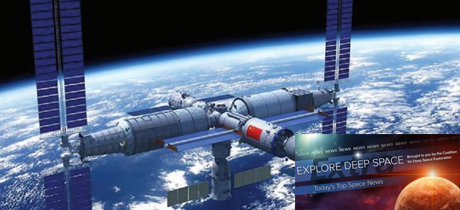In Today’s Deep Space Extra… Industry executive warns about competition from China’s space station. NASA’s Curiosity rover celebrates nine years on Mars this week.
Human Space Exploration
China’s space station emerges as competitor to commercial ventures
Coalition Member in the News – Nanoracks
SpaceNews.com (8/5): During a conference presentation on August 4, Jeffrey Manber, CEO of Nanoracks, said his company has already lost business to China’s space station, adding that this is a reminder for the need of the U.S. to attract international users of the International Space Station (ISS). Manber stated that he expects the ISS to be replaced by several commercial platforms, optimized for specific applications ranging from tourism to research and designed from the beginning for commercial use, which is not the case of the ISS today. “The ISS was a political station as well as a technical marvel, but the rules and regulations that have to be in place do limit the market of what you can do,” said Manber.
Space Science
What does the edge of the solar system look like?
Space.com (8/4): NASA’s Voyager I, which launched in 1977, crossed into interstellar space in 2012. Voyager 2, also launched in 1977, repeated the feat of crossing the solar system’s outer boundary in 2018. Together, they first exposed a sudden decrease in solar particles and a sharp rise in galactic radiation as they crossed the boundary. A new NASA mission, the Interstellar Mapping and Acceleration Probe (IMAP) is targeting launch in 2025 to advance the characterization.
9 years on Mars! Curiosity rover marks another anniversary
Space.com (8/5): NASA’s Curiosity rover has now been exploring Mars for nine years. Ever since, the rover has been helping scientists better understand Mars’ past habitability and how the planet has changed over time. Curiosity has made a number of intriguing finds, including the discovery of organic chemicals, the carbon-containing building blocks of life as we know it, and the detection of several spikes in the concentration of methane, which here on Earth is generated primarily by living creatures.
Scientists figure out how the asteroid belt attacked the dinosaurs
Universe Today (8/4): Using computer modeling as well as geological analysis, scientists from the Southwest Research Institute have traced the likely source of the more than six-mile-wide object that slammed into the Earth an estimated 66 million years ago to the outer asteroid belt between Mars and Jupiter. The object that struck Mexico’s Yucatan Peninsula and led to the demise of much of life on Earth, including the dinosaurs, was likely a carbonaceous chondrite, an object common among the asteroids that pass close to the Earth.
Other News
National Reconnaissance Office exercises contract option for Maxar satellite imagery
Coalition Members in the News – Maxar
SpaceNews.com (8/4): The U.S. National Reconnaissance Office (NRO) has exercised a second one-year option with Maxar Technologies for the acquisition of satellite imagery. Maxar is the NRO’s largest supplier of commercial satellite imagery. The company operates three high-resolution imaging satellites — WorldView-1, 2 and 3 — and is building a more advanced WorldView Legion constellation.
New details of Russian “movie in space” emerge as producers seek funding
SpaceNews.com (8/4): New details are surfacing over plans for a Russian-sponsored drama that is to be filmed aboard the Russian segment of the International Space Station (ISS). The plot involves a cosmonaut who experiences cardiac arrest during a spacewalk and requires emergency surgery. A female cardiac surgeon must be launched to perform the surgery before the cosmonaut can return to Earth. The details emerged during a fund-raising event for the production. Director Klim Shipenko will be launched to the ISS with a female actress for an October filming session. The director and actress will be launched with professional cosmonaut Anton Shkaplerov aboard the Soyuz MS-19 to support the production.

